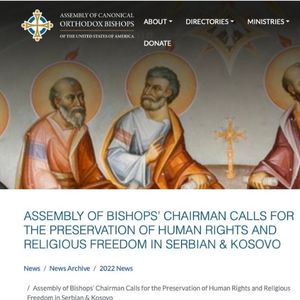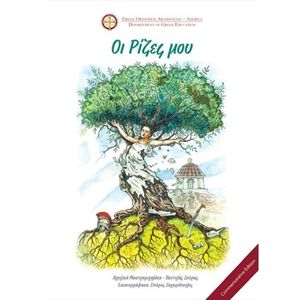Saint Barbara News
01/08/2023
Sunday, January 8 - Sunday After the Feast of Theophany - Κυριακή Μετά Τα Άγια Θεοφάνεια
Οrthros - Ορθρος... 8:30 a.m.
Divine Liturgy - Θεία Λειτουργία... 9:45 a.m.
Sunday School - Κατηχητικό Σχολείο ... 9:45 a.m.
Blessing and Cutting of the Parish Vasilopita - Ευλογία και Κοπή της Κοινοτικής Βασιλόπιτας ... 11:15 a.m.
General Assembly - Γενική Συνέλευση ... 12:00 p.m.
Coffee Fellowship
Saint Barbara Youth Division Basketball vs. Holy Trinity (NR) at Bridgeort ... 2:00 p.m.
Monday, January 9
Red Cross Blood Drive - Αιμοδοσία του Ερυθρού Σταυρού ... 9:30 a.m. - 2:30 p.m.
Parish Council Meeting - Συνεδρίασις Κοινοτικού Συμβουλίου ... 7:00 p.m.
Athletics Practice-Προπόνηση Αθλητικών-Volleyball - CT Sports Center, Woodbridge ... 7:30 p.m.
Wednesday, January 11
Athletics Practice - Προπόνηση Αθλητικών -
Youth Division & Varsity Basketball - CT Sports Center, Woodbridge... 7:30 p.m.
Thursday, January 12
Greek Language School - Ελληνικό Σχολείο ... 4:30 p.m.
Sunday, January 15 - 12th Sunday of Luke - Κυριακή 'IB Λουκά
Οrthros - Ορθρος... 8:30 a.m.
Divine Liturgy - Θεία Λειτουργία... 9:45 a.m.
Sunday School - Κατηχητικό Σχολείο ... 9:45 a.m.
Coffee Fellowship
Saint Barbara Youth Division Basketball vs. Holy Trinity (Bpt) at Bridgeort ... 1:00 p.m.
Saint Barbara Varsity Division Basketball vs. Holy Trinity (NR) at Stamford ... 4:00 p.m.
Memorials:
01/08/2023
Trisagion:
Antonios and Anastasia Antonellis
Stewardship 2022
01/08/2023
Financial Update
01/01/2023
Saint Barbara General Fund
2022 Financial Summary
Total Annual Budget: $718,000*
Total Income: $720,178
Total Expense: $730,255
* Does not include mortgage payment of $19,053 a month
Light A Candle Program
“LIGHT A CANDLE” PROGRAM
As we continue to follow precautions and guidelines that due to COVID-19 you are invited to participate in the Candle Lighting Ministry.
Many parishioners have been expressing a desire to have candles lit inside the Church for them, or for their family, friends or prayers for the world.
If you prefer to mail a check, instead of making an online donation or Venmo, please make check payable to: Saint Barbara Greek Orthodox Church and mail to: 480 Racebrook Road, Orange, CT 06477.
Your donation will continue to support the ministry of the Saint Barbara Greek Orthodox Church of Orange, Connecticut. Thank you.
Online Giving Reminder
Saint Barbara Church’s online giving program makes it possible to make contributions of various kinds to Saint Barbara Church online. Our secure system allows you to conveniently make donations online. You can choose to make a one-time contribution or establish a recurring weekly or monthly contribution. Best of all, you don’t need to remember to write a check or bring your offering to church - it’s already taken care of! Payments can be made via checking account, savings account, credit card or debit card. Visit (https://bit.ly/STBDonations) to get started.






 In light of the developing situation between Serbia and Kosovo, including the prevention of Patriarch Porfirije on December 26, 2022 by the authorities in Pristina to visit his historic and primatial see of Peć, His Eminence Archbishop Elpidophoros of America, in his capacity as Chairman of the Assembly of Bishops, conveyed an intervention to The Honorable Secretary of State Antony Blinken. In the letter, the chairman asks Secretary Blinken:
In light of the developing situation between Serbia and Kosovo, including the prevention of Patriarch Porfirije on December 26, 2022 by the authorities in Pristina to visit his historic and primatial see of Peć, His Eminence Archbishop Elpidophoros of America, in his capacity as Chairman of the Assembly of Bishops, conveyed an intervention to The Honorable Secretary of State Antony Blinken. In the letter, the chairman asks Secretary Blinken:
 In response to an overwhelming interest in the Summer 2023 camping ministry programs and in an effort to accommodate as many participants as possible, the Office of Ionian Village is updating its Summer 2023 dates.
In response to an overwhelming interest in the Summer 2023 camping ministry programs and in an effort to accommodate as many participants as possible, the Office of Ionian Village is updating its Summer 2023 dates.
 The Office of Greek Education, in cooperation with the High Council for Greek Education, is delighted to announce the publication of "H Rizes Mou." The book presents a glimpse into the Greek culture and its traditions. Educational and picturesque, this book teaches by example. Full color illustrations and informative text introduce Greek Orthodox holidays, traditions and cultural events that are observed.
The Office of Greek Education, in cooperation with the High Council for Greek Education, is delighted to announce the publication of "H Rizes Mou." The book presents a glimpse into the Greek culture and its traditions. Educational and picturesque, this book teaches by example. Full color illustrations and informative text introduce Greek Orthodox holidays, traditions and cultural events that are observed.